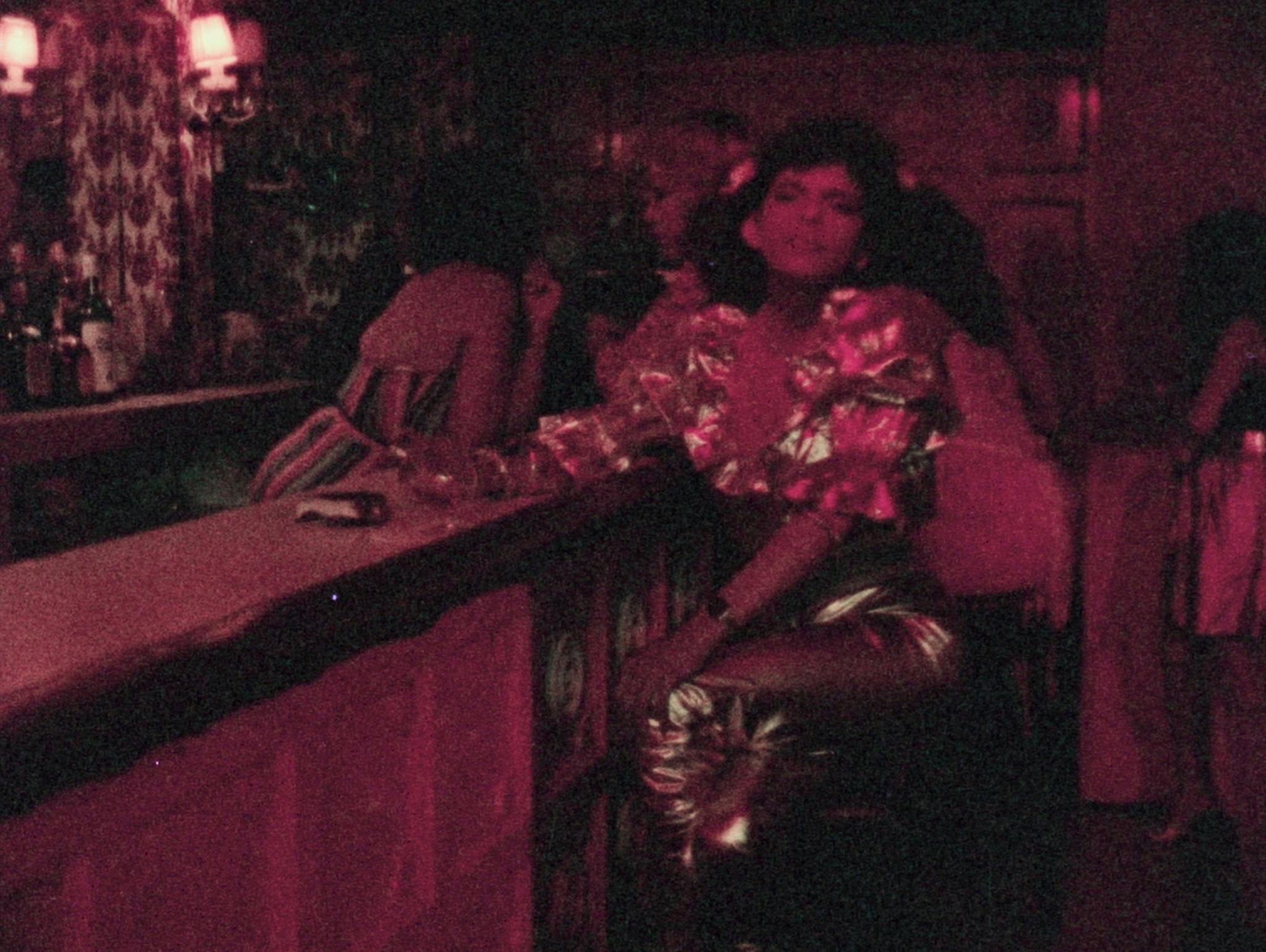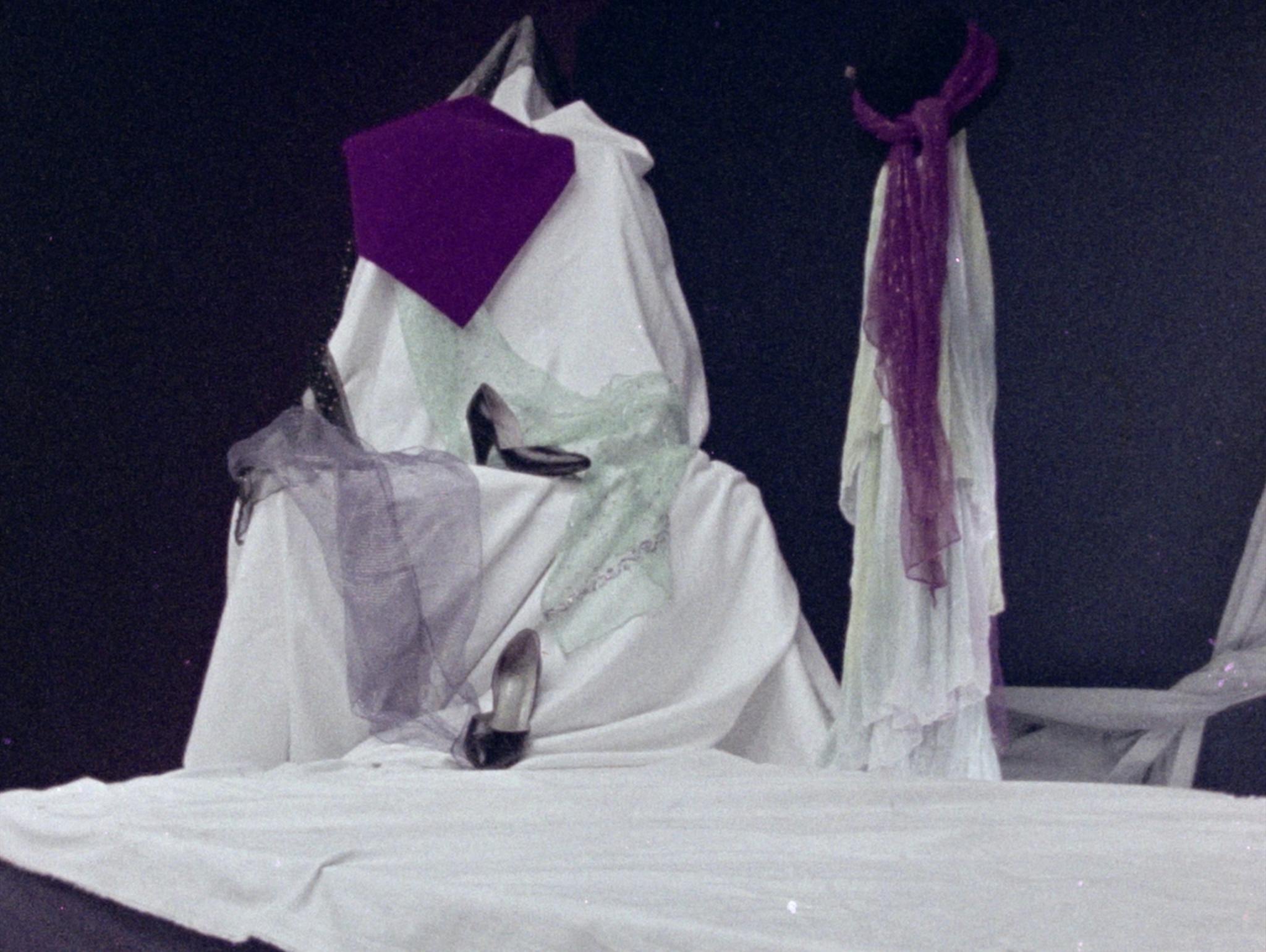Manuel Herreros de Lemos and Mateo Manaure Arilla, Trans, 1982 (still). 16 mm film transferred to video, sound, 22 min, 5 sec. Institute for Studies of Latin American Art (ISLAA) Library and Archives ⓒ Manuel R. Herreros de Lemos

Fig. 1. Manuel Herreros de Lemos and Mateo Manaure Arilla, Trans, 1982 (still). 16mm film transferred to video, sound, 22:05 min. Institute for Studies of Latin American Art (ISLAA) Library and Archives ⓒ Manuel R. Herreros de Lemos

Fig. 2. Manuel Herreros de Lemos and Mateo Manaure Arilla, Trans, 1982 (still). 16mm film transferred to video, sound, 22:05 min. Institute for Studies of Latin American Art (ISLAA) Library and Archives ⓒ Manuel R. Herreros de Lemos

Fig. 3. Manuel Herreros de Lemos and Mateo Manaure Arilla, Trans, 1982 (still). 16mm film transferred to video, sound, 22:05 min. Institute for Studies of Latin American Art (ISLAA) Library and Archives ⓒ Manuel R. Herreros de Lemos

Fig. 4. Manuel Herreros de Lemos and Mateo Manaure Arilla, Trans, 1982 (still). 16mm film transferred to video, sound, 22:05 min. Institute for Studies of Latin American Art (ISLAA) Library and Archives ⓒ Manuel R. Herreros de Lemos

Fig. 5. Manuel Herreros de Lemos and Mateo Manaure Arilla, Trans, 1982 (still). 16mm film transferred to video, sound, 22:05 min. Institute for Studies of Latin American Art (ISLAA) Library and Archives ⓒ Manuel R. Herreros de Lemos

Fig. 6. Manuel Herreros de Lemos and Mateo Manaure Arilla, Trans, 1982 (still). 16mm film transferred to video, sound, 22:05 min. Institute for Studies of Latin American Art (ISLAA) Library and Archives ⓒ Manuel R. Herreros de Lemos
The Writer in Residence series offers scholars the opportunity to conduct research on Latin American art through materials in the ISLAA Library and Archives.
Trans, a documentary by Manuel Herreros de Lemos and Mateo Manaure Arilla, proposes an experiment of form. Through its stylistic heterogeneity, the film offers a glimpse into a temporality that houses the future within its present. Produced in 1982, the documentary explores the lives of a group of trans women in Caracas. Trans was shot on 16-millimeter film and premiered at the Cinemateca Nacional de Venezuela in 1983, gaining significant local press coverage and screenings at several venues and festivals throughout the country. After being lost for several decades, the film was recently restored and digitized. The documentary raises questions about the politics of film as archive and as a medium for testimony, while highlighting issues of queer temporality and performance.
Trans opens with images of a city at night. The scratched composition constructs an urban landscape filled with illuminated billboards, bustling cars, and shimmering streetlights. In the initial shot, we see the Plaza Venezuela fountain in the distance, surrounded by a multitude of urban stimuli (fig 1). The sequence gradually zooms in to reveal the fountain in full detail, its red and orange lights creating a spectacle that emphasizes the significance of this landmark in the film. As Marcia Ochoa has explained, the transformistas who are shown walking up to cars, amid wide avenues packed with traffic, are a fundamental part of the urban fabric of Caracas. According to Ochoa, in Venezuela the term “transformista” is used to refer to people who are assigned male at birth 1 and “live their lives through the gender that society claims does not correspond to them (feminine).” 2 Ochoa explains that the term is associated with sex work and employed for “self-definition,” but that not all trans women identify with it. 3 The aerial shots in this initial sequence, which gradually zoom in, establish the narrative within a cosmopolitan, vibrant landscape of dynamism and modernity. The distanced shots of the city portray it as a space of multiplicity where infinite narratives and stories might be unfolding.
Amid bustling nightlife, we are introduced to Venezuela, a trans woman who is performing Irene Cara’s song Fame at Club Sinfonía (fig. 2). In her fur bikini and translucent robe, she performs for both the camera and the club’s patrons, some of whom we catch casual glimpses of. Venezuela commands the attention of the room, often locking eyes with the viewers. “My name is Venezuela, I am a transformista. I work at this nightclub. It’s my medium but not my goal.” Sitting at the bar, she explains her determination to achieve her goals in the future, both “sexually and as a person” (fig. 3). Venezuela’s is the first in a series of interviews with trans women that make this documentary an archive of experiences and life stories. Her performance concludes with her lip-syncing to the lyrics “I'm gonna live forever / Baby, remember my name.” Irene Cara’s words encapsulate her performance and testimony within a filmic archive that contributes to the informal modes of register that had already disseminated her figure. 4 In the next scene, we see another trans woman getting ready in her bedroom. She puts on her tights, brushes her hair, and picks a dress from her closet (fig. 4). This sequence unfolds at a much slower pace and is less saturated in terms of color, calling attention to the meticulous process of getting dressed. In dialogue with Venezuela’s performance, the documentary alternates between intimate scenes and public events, underscoring different practices of the body at the margins of societal norms. These gestures constitute a form of repertoire, as defined by Diana Taylor: ephemeral modes of expression communicated through the body that produce and transmit an embodied form of memory. 5 Both Venezuela’s gestures when lip-syncing and the women’s movements while fixing her hair serve as archival traces in the liminal space between written and embodied practices that is created in their inscription onto celluloid.
Overall, the abundant images of trans women getting ready epitomize the film’s focus on practices of the body and its centrality of the ornamental. The gestures of the woman in her room are captured with care, set to a melancholic song. She looks in the mirror, applies creams, and brushes her hair. Later, images of the beauty salon Melenitas appear on screen, with lighthearted opera music introducing a stark tonal shift. The issue of gender identity is thus approached through different affective registers, ranging from introspection and self-reflection to spaces of sociability. At Melenitas, we see several women who are also having their hair styled. The camera focuses on one of them, panning down her whole body from her black stilettos to her nearly completed hairdo (fig. 5). The film then cuts to a photography studio, where shoes and accessories are arranged on a set (fig. 6). As Bolívar Echevarría notes, queerness shares with mannerist and baroque aesthetics a predilection for what is culturally considered “artificial,” over that which is hegemonically deemed “natural.” 6 For him, “queerness is an announcement or prefiguration of a utopian or messianic ‘nature’ or ‘normality’ in human life.” 7 Queerness produces a sense of futurity through the prospective deconstruction of the dichotomic notions of “natural” and “artificial.” Esteban Muñoz explains that “both the ornamental and the quotidian can contain a map of the utopia that is queerness.” 8 Trans emphasizes the potentiality of self-determination, visibility, and the liberatory act of choosing one’s own appearance. The film creates a map of political gestures rooted in the exploration of surface’s depth, of the profoundness of the mirrored image. In the words of artist Argelia Bravo, who has worked with transformistas in the Venezuelan association and activist collective Transvenus, these women “craft an image and an anti-normative aesthetic that challenges our established gender schemes, excluding them from the social, economic, legal, and political framework.” 9 This non-normativity is a negotiation of artifice and nature, in the terms exposed by Echeverría, that problematizes both concepts and is made visible in the documentary through the representation of rituals of the body.
The documentary adopts an expository mode, as classified by film critic Bill Nichols, that is later distorted and transgressed in multiple ways. The film contains interviews with trans women, passersby, and authorities—including a doctor, who shares problematic statements. In an interview in a local newspaper, the filmmakers stated that “the diversity of opinions allows the public to reflect on the problematic.” Be that as it may, this does not mean that every statement is deemed valuable or reasonable. The filmmakers subvert the notion of objectivity or neutrality in nonfiction cinema, formally denouncing some of the views expressed. Views that were hegemonic and normative at the time are particularly mocked: a priest and a policeman speak of the existence of transformistas as criminal and unnatural, but before they can finish their remarks, they are silenced by the sound of music. The men remain on screen for a few seconds, but we cannot hear their voices. This formal choice brings to the fore the artificial nature of documentary filmmaking, making tangible the mediating process of granting access to specific views but not others. By problematizing and subtly denouncing the hate speech of the priest and the police officer, Trans steps away from a documentary practice that belongs to what Nichols calls “discourses of sobriety,” which “regard their relation to the real as direct, immediate, transparent.” 10 In this case, the film’s aesthetic form underscores the contingency of documentary filmmaking’s expository mode and of the discourses of authority from specific agents. Moreover, the replacement of voice with music is also an opening gesture that enacts the possibility of countering hate speech through humorous strategies.

Fig. 7. Manuel Herreros de Lemos and Mateo Manaure Arilla, Trans, 1982 (still). 16 mm film transferred to video, sound, 22 min, 5 sec. Institute for Studies of Latin American Art (ISLAA) Library and Archives ⓒ Manuel R. Herreros de Lemos

Fig. 8. Manuel Herreros de Lemos and Mateo Manaure Arilla, Trans, 1982 (still). 16 mm film transferred to video, sound, 22 min, 5 sec. Institute for Studies of Latin American Art (ISLAA) Library and Archives ⓒ Manuel R. Herreros de Lemos

Fig. 9. Manuel Herreros de Lemos and Mateo Manaure Arilla, Trans, 1982 (still). 16 mm film transferred to video, sound, 22 min, 5 sec. Institute for Studies of Latin American Art (ISLAA) Library and Archives ⓒ Manuel R. Herreros de Lemos

Fig. 10. Manuel Herreros de Lemos and Mateo Manaure Arilla, Trans, 1982 (still). 16 mm film transferred to video, sound, 22 min, 5 sec. Institute for Studies of Latin American Art (ISLAA) Library and Archives ⓒ Manuel R. Herreros de Lemos
The film’s formal choices contribute to its affective flexibility, which highlights the complexity of the reality of its protagonists. As viewers, we witness ironic moments such as the one described above, but we are also exposed to sobering events. The documentary includes a scene in which police officers run after trans women on the street, holding and detaining some of them (fig. 7). In the words of film scholars Bhaskar Sarkar and Janet Walker, “the vocation of testimony is archival, and, jointly, the vocation of the archive is ethical.” 11 Throughout the film, several trans women are interviewed, some of which highlight the violence and abuse they experience daily (fig. 8). “People look at me because I attract a lot of attention . . . They yell at me, ‘transformista,’ ‘man,’ and a lot of nasty things I don’t want to repeat here. Human rights should be applied here. We are all humans. We have the capacity to be respected. Just yesterday a friend was buried, run over, and beaten.” In this context of persecution and violence active forms of association take place. “In my house, people don’t treat me badly . . . Marginalized people who have no society . . . they accept me as I am.” Another woman also describes the constant street harassment she faces. She states, “I am not a person who has two heads or three hands . . . I walk by and they are terrified to see me because I am a transformista, but why are they scared? Why? This is a normal thing . . . I have to dress how I feel, because I feel like a woman.” This cinematic archive of testimonies reaches into the future. It constitutes a claim for the protection of human rights, for trans women’s fight against violence and discrimination, which is supported by passersby and is opposed to the discourses of the priest and the police officer. In the words of researcher Quiteria Franco, nowadays Venezuela still lacks “a broad and comprehensive law that guarantees the right to equality and non-discrimination, and includes the protection of lesbian, gay, bisexual, trans, and intersex persons against discrimination due to sexual orientation, identity, gender expression or related characteristics.” 12 Trans forms a dynamic archive, one that is in dialogue with multiple chronologies.
At the end of the film, we are taken back to Club Sinfonía, where Venezuela expresses her desire to step into the fountain at Plaza Venezuela. She imagines herself “walking through the waters without sinking, saying goodbye, and then reaching my goal, Europe.” In her vision, she’ll arrive at this symbol of the nation “beautiful, as I am: beautiful, shocking, transformista.” The film cuts from the red atmosphere of the club to the red water of the fountain, creating a continuity between the different nighttime spaces inhabited by Venezuela. Here, color saturation indexes the utopian promise held by artifice, one that materializes desire. The fountain is approached from a variety of angles and distances that quickly follow one another, constructing a rhythmic portrait of the space. In this climactic scene, we see Venezuela getting out of a car with other women. She removes a “do not enter” sign and they all get into the fountain, walking over a pathway that has formed on the grass (fig. 9). The merengue song “Abusadora,” by Billo's Caracas Band plays in the background. As Marcia Ochoa has explained, the urban spaces in which transformistas work are their runways. They transform urban space, specifically the large avenues where they are frequently persecuted by the police, “into a catwalk where they can shine.” For Ochoa, “in this transformation, they impose themselves onto the urban and national imaginary in an indelible way.” 13 Here, they walk this improvised runway holding hands (fig. 10). For more than two minutes, transformistas inhabit the illuminated fountain in a celebratory gesture that points toward the future while stating the urgency of the present. This scene of joy and exultation encapsulates the reflection on temporality and space offered by the documentary. I draw inspiration from José Esteban Muñoz’s notion of futurity, of “what the collective and the larger social order could be.” 14 In this context, the performance in the fountain holds “utopian potentiality;” it is a gesture rooted in the desire to decide one’s own fate, to externalize and materialize agentic expressions. If queerness is not yet here, if it is a form of futurity, as Muñoz has explained, the action at the Plaza Venezuela constitutes a messianic moment as understood by Walter Benjamin, one that ruptures linear time with its proleptic nature.
In the words of Muñoz, “performativity and utopia both call into question what is epistemologically there and signal a highly ephemeral ontological field that can be characterized as a doing in futurity.” 15 Muñoz’s notion of ephemera can also illuminate our understanding of this last scene. The fleeting action of the transformistas persists through its inscription in film; we can observe “evidence of what has transpired but certainly not the thing itself.” 16 Ephemera has to do with “traces, glimmers, residues, and specks of things,” and it allows us to conceptualize alternative understandings of archival practices in cinema. The action on screen constitutes a trace of the event, a mediation that collapses chronological categorization because it configures futurity and desire, extending beyond a register of pastness. The staged nature of the scene, its connection to artifice and ornament, blurs the limits between fiction and nonfiction, fantasy and reality, present and future. The problematization of the artificiality of documentary filmmaking that we saw in the film’s formal denunciation of hegemonic discourses is also extended to the archive. Through Trans we witness the creation of an important archive that gathers testimonies of violence alongside playful and contingent moments. This repository reaches into the future most strikingly through its celebratory ending. Its conclusion remains open, refusing narrative closure. The “indelible” way in which transformistas participate in the national imaginary 17 does not contradict the concept of ephemera: ephemera is here a form of permanence in time and space, a refusal to be erased.